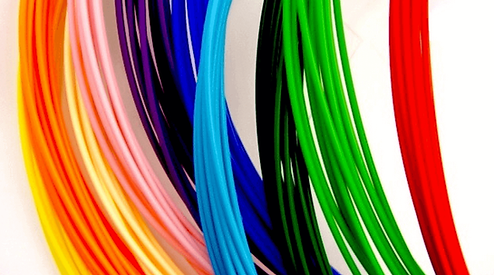
Aquasolve PVA
Polyvinyl alcohol is widely used in industries, such as the textile and papermaking (adhesive, paints, textiles, …). It also has applications in the food industry as binding and coating agent. It is specially used as coating when moisture barrier or protection properties are needed [3] [1].
> Bibliography
[1] ”Polyvinyl Alcohol”, http://www.primaryinfo.com/projects/polyvinyl-alcohol.htm, accessed on 10/05/2017.
[2] S.K.Saxena, “Polyvinyl Alcohol (PVA)”, http://www.fao.org/fileadmin/templates/agns/pdf/jecfa/cta/61/PVA.pdf, accessed on 10.05/2017.
[3] “Polyvinyl Alcohol”, https://en.wikipedia.org/wiki/Polyvinyl_alcohol#/media/File:Polyvinyl_Alcohol_Structural_Formula_V1.svg, accessed on 10/05/2017.
[4] http://pslc.ws/macrog/images/pva02.gif, accessed on 10/05/2017.
[5] FormFutura, ”AquaSolve PVA”, http://www.formfutura.com/formfutura-175mm-aquasolve-pva.html, accessed on 10/05/2017.
> Conclusion
As the HIPS polymer, the best interest of AquaSolve PVA is in dual extrusion 3D printing. Indeed, it is rapidly cold water soluble, bonds extremely well to thermoplastic and is “easy to print” at low temperatures. This makes it an interesting support for complex prints with ABS or PLA. After 3D printing, the dissolution can be accelerated by warm water [3].
The polymer should be carefully stored, at ambient temperature, in a dry and ventilated room and in a closed container with desiccant. Indeed, AquaSolve PVA needs to be protected from water, moisture, direct sunlight and source of ignition. Regarding the printing parameters, the recommended extrusion temperature range is 180 to 205°C. A previous drying in an oven is advised. Moreover, the bed temperature can be the same as the one for PLA or ABS, because PVA sticks as well to a non-heated bed as to a heated one. The use of blue tape can help the polymer to stick to the bed [5].
By comparison to HIPS, the other filament commonly used as a support, the AquaSolve PVA is less easy to print but is easier to remove from the desire object.
> As printing material
> Properties
AquaSolve PVA is a colourless and odourless water soluble filament. It is non-toxic and biodegradable once dissolved in water [5]. It exhibits excellent adhesive properties, and is resistant to oil and grease. Is has a high tensile strength and flexibility, as well as an oxygen and aroma barrier [2].
The product specifications of the aquasolve PVA filament can be found in the datasheet published by FormFutura [5] and are summarized in the table 1.
AquaSolve PVA is a semicrystalline thermoplastic material made of polyvynil alcohol (>75%), aliphatic polyol (<20%) and calcium distearate (<5%). It is a new filament which fabrication process is not available. The interest is then brought to the polyvynil alcolol itself.
Polyvynil alcohol, which formula is given by figure 1, is not prepared by polymerisation by the corresponding monomers. The first step of the manufacture is the polymerisation of vinyl acetates monomers. Then, as can be seen in figure 2, it is obtained by hydrolysis of polyvinyl acetate to replace ester group in vinyl acetate with the hydroxyl group, usually in a continuous process. This is achieved in presence of aqueous sodium hydroxide gradually added. Polyvinyl alcohol is then precipitated, washed and dried. The physical characteristics obtained and its specific functional uses depend on the degree of polymerization and the degree of hydrolysis [1][2].
> Chemical composition and synthesis


Figure 1 : polyvynil alcohol [CH2CH(OH)]n [3].
Figure 2 : Hydrolysis of polyvinyl acetate [4]

Table 1 : Properties of AquaSolve PVA
> Applications
Aquasolve polyvinyl alcohol is a non-toxic material, which benefits from high adhesive, strength and flexibility properties and is therefore widely used in textile industry or as coating agent. This material is an interesting 3D printing support for dual extrusion with ABS with PLA. It is easily dissolved in water but is not as easy to print as HIPS, which is the reason why is was not chosen over HIPS for further characterizations.
By Marine